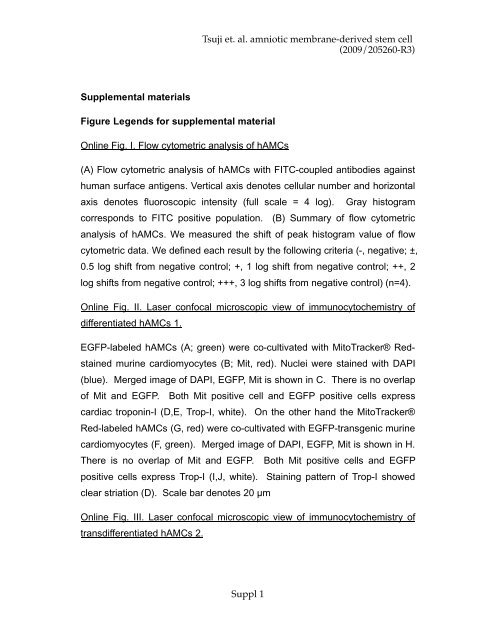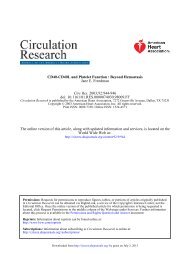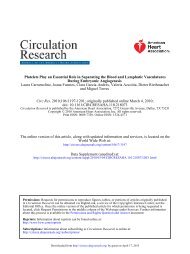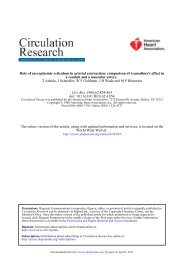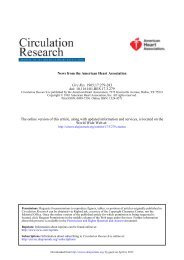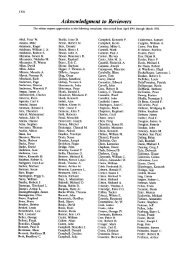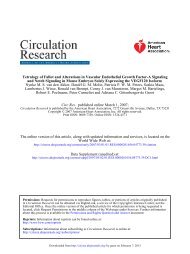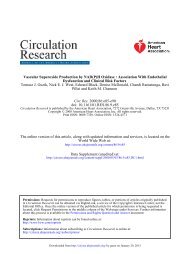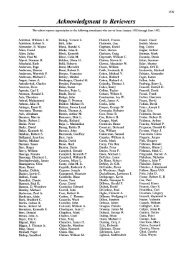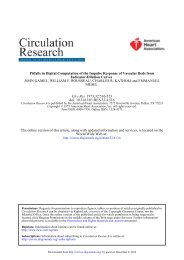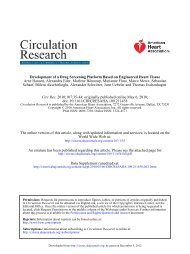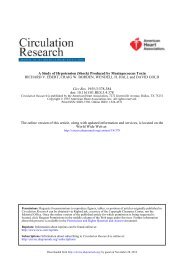Tsuji et. al. amniotic membrane-derived stem cell (2009/205260-R3 ...
Tsuji et. al. amniotic membrane-derived stem cell (2009/205260-R3 ...
Tsuji et. al. amniotic membrane-derived stem cell (2009/205260-R3 ...
Create successful ePaper yourself
Turn your PDF publications into a flip-book with our unique Google optimized e-Paper software.
<strong>Tsuji</strong> <strong>et</strong>. <strong>al</strong>. <strong>amniotic</strong> <strong>membrane</strong>-<strong>derived</strong> <strong>stem</strong> <strong>cell</strong><br />
(<strong>2009</strong>/<strong>205260</strong>-<strong>R3</strong>)<br />
Supplement<strong>al</strong> materi<strong>al</strong>s<br />
Figure Legends for supplement<strong>al</strong> materi<strong>al</strong><br />
Online Fig. I. Flow cytom<strong>et</strong>ric an<strong>al</strong>ysis of hAMCs<br />
(A) Flow cytom<strong>et</strong>ric an<strong>al</strong>ysis of hAMCs with FITC-coupled antibodies against<br />
human surface antigens. Vertic<strong>al</strong> axis denotes <strong>cell</strong>ular number and horizont<strong>al</strong><br />
axis denotes fluoroscopic intensity (full sc<strong>al</strong>e = 4 log). Gray histogram<br />
corresponds to FITC positive population. (B) Summary of flow cytom<strong>et</strong>ric<br />
an<strong>al</strong>ysis of hAMCs. We measured the shift of peak histogram v<strong>al</strong>ue of flow<br />
cytom<strong>et</strong>ric data. We defined each result by the following criteria (-, negative; ±,<br />
0.5 log shift from negative control; +, 1 log shift from negative control; ++, 2<br />
log shifts from negative control; +++, 3 log shifts from negative control) (n=4).<br />
Online Fig. II. Laser confoc<strong>al</strong> microscopic view of immunocytochemistry of<br />
differentiated hAMCs 1.<br />
EGFP-labeled hAMCs (A; green) were co-cultivated with MitoTracker® Redstained<br />
murine cardiomyocytes (B; Mit, red). Nuclei were stained with DAPI<br />
(blue). Merged image of DAPI, EGFP, Mit is shown in C. There is no overlap<br />
of Mit and EGFP. Both Mit positive <strong>cell</strong> and EGFP positive <strong>cell</strong>s express<br />
cardiac troponin-I (D,E, Trop-I, white). On the other hand the MitoTracker®<br />
Red-labeled hAMCs (G, red) were co-cultivated with EGFP-transgenic murine<br />
cardiomyocytes (F, green). Merged image of DAPI, EGFP, Mit is shown in H.<br />
There is no overlap of Mit and EGFP. Both Mit positive <strong>cell</strong>s and EGFP<br />
positive <strong>cell</strong>s express Trop-I (I,J, white). Staining pattern of Trop-I showed<br />
clear striation (D). Sc<strong>al</strong>e bar denotes 20 !m<br />
Online Fig. III. Laser confoc<strong>al</strong> microscopic view of immunocytochemistry of<br />
transdifferentiated hAMCs 2.<br />
Suppl 1
<strong>Tsuji</strong> <strong>et</strong>. <strong>al</strong>. <strong>amniotic</strong> <strong>membrane</strong>-<strong>derived</strong> <strong>stem</strong> <strong>cell</strong><br />
(<strong>2009</strong>/<strong>205260</strong>-<strong>R3</strong>)<br />
Unmerged images of Fig. 2F are shown. Please see d<strong>et</strong>ail in the legend of<br />
Fig. 2. Striation pattern of differentiated hAMCs in the white box of panel D<br />
were expanded and shown in panel F-H. Clear striation pattern of !-actinin<br />
(red; F) is observed. !-actinin and EGFP-staining (green;G) were observed<br />
<strong>al</strong>ternately in striated manner, suggesting !-actinin is expressed in EGFP<br />
positive <strong>cell</strong>. Sc<strong>al</strong>e bar denotes 20!m<br />
Online Fig. IV. Haemodynamic param<strong>et</strong>er in myocardi<strong>al</strong> infarction model of<br />
nude rat in vivo<br />
Measured LV param<strong>et</strong>ers by echocardiogram are averaged and shown at 2<br />
weeks and 4 weeks after the myocardi<strong>al</strong> infarction (MI). (A) The left<br />
ventricular end-diastolic dimension (LVEDd) and (B) end-systolic dimension<br />
(LVESd) tended to improve; however, there was no statistic<strong>al</strong> significance.<br />
There was no difference in the diam<strong>et</strong>er of (C) the anterior left ventricular w<strong>al</strong>l<br />
thickness (AW), and (D) posterior left ventricular w<strong>al</strong>l thickness (PW).<br />
Measured (E) left ventricular systolic pressure (LVSP), (F) left ventricular enddiastolic<br />
pressure (LVEDP), (G) maximum positive developed left ventricular<br />
pressure (LV dP/dt), are averaged and shown. The MI+hAMC group showed<br />
slight improvement in LVSP and LV dP/dt. There is, however, no statistic<strong>al</strong><br />
significance.<br />
Online Fig V. Evidence of long term surviv<strong>al</strong> of EGFP-positive cardiomyocytes<br />
in Wistar rat heart<br />
(A) Number of injected <strong>cell</strong>s, d<strong>et</strong>ected EGFP-positive/cardiac troponin-I<br />
positive cardiomyocytes, and % surviving <strong>cell</strong>s as a function of the number of<br />
days after the transplantation are shown. (B-G) Representative confoc<strong>al</strong><br />
laser microscopic view of the immunohistochemic<strong>al</strong> an<strong>al</strong>ysis using anticardiac<br />
troponin-I (Trop-I) antibody at the day after transplantation. Although<br />
fluorescent intensity of EGFP was decayed as a function of the time after<br />
Suppl 2
<strong>Tsuji</strong> <strong>et</strong>. <strong>al</strong>. <strong>amniotic</strong> <strong>membrane</strong>-<strong>derived</strong> <strong>stem</strong> <strong>cell</strong><br />
(<strong>2009</strong>/<strong>205260</strong>-<strong>R3</strong>)<br />
transplantation, there is no significant decrease in % surviving <strong>cell</strong>s. Sc<strong>al</strong>e<br />
bars denote 50 µm.<br />
Online Fig VI Massive surviv<strong>al</strong> of EGFP-positive hAMCs and<br />
transdifferentiation into cardiomyocytes in Wistar rat heart.<br />
Laser confoc<strong>al</strong> microscopic view of immunohistochemistry with anti-cardiac<br />
troponin-I antibody (Trop-I; red, C). Nuclei were stained with DAPI (blue, A).<br />
Many EGFP-positive (EGFP; green, B) rod-shaped <strong>cell</strong>s expressed Trop-I<br />
and were survived in the Wistar rat heart even at 2 weeks after the<br />
transplantation. Images of A-C were superimposed and shown in D. Sc<strong>al</strong>e in<br />
panel A denotes 50µm.<br />
Online Fig VII. Laser confoc<strong>al</strong> microscopic view of immunohistochemistry of<br />
transdifferentiated hAMCs in the Wistar rat heart.<br />
Unmerged images of Fig 4 C and Fig 4 D are shown in A-F and F-J,<br />
respectively. Please see d<strong>et</strong>ail in the legend of Fig. 4.<br />
Online Fig VIII. Laser confoc<strong>al</strong> microscopic view of immunohistochemistry of<br />
transdifferentiated hAMCs in the EGFP-transgenic mouse heart.<br />
Non EGFP-labeled hAMCs were transplanted into myocardi<strong>al</strong> infarction area<br />
of EGFP-transgenic mouse heart. Two weeks after the transplantation, laser<br />
confoc<strong>al</strong> microscopic view of immunohistochemistry with anti-!-actinin (!-<br />
actinin; red C). Nuclei were stained with DAPI(blue, A). Many EGFP-negative<br />
(EGFPl; green, B) rod-shaped <strong>cell</strong> expressed !-actinin were survived in the<br />
mouse heart even at 2 weeks after the transplantation. Images of A-C were<br />
superimposed and shown in D. White box area in D was expanded and<br />
shown in E. Clear striation staining pattern of !-actinin was observed in<br />
EGFP-negative hAMCs <strong>derived</strong> <strong>cell</strong>s. Sc<strong>al</strong>e in panel C denotes 50µm.<br />
Online Fig IX. Laser confoc<strong>al</strong> microscopic view of immunohistochemistry of<br />
Suppl 3
<strong>Tsuji</strong> <strong>et</strong>. <strong>al</strong>. <strong>amniotic</strong> <strong>membrane</strong>-<strong>derived</strong> <strong>stem</strong> <strong>cell</strong><br />
(<strong>2009</strong>/<strong>205260</strong>-<strong>R3</strong>)<br />
regulatory T <strong>cell</strong>s in the Wistar rat heart.<br />
Unmerged images of Fig 5 E are shown. Please see d<strong>et</strong>ail in the legend of<br />
Fig. 5.<br />
Online Fig X. In vitro transdifferentiation ability of hAMCs to the other organs.<br />
Laser confoc<strong>al</strong> microscopic view of immunocytochemistry. Hepatogenic<br />
differentiation (A,D), pancreogenesis (B), osteogenesis (C), and neurogenesis<br />
(E,F) were examined (See <strong>al</strong>so supplement<strong>al</strong> Materi<strong>al</strong> and M<strong>et</strong>hod 3).<br />
Transdifferentiated hAMCs expressed organ specific antigens, however, failed<br />
to show organ specific morphology in vitro (A,D,E,F). Sc<strong>al</strong>e bars denote<br />
50µm.<br />
Online Fig XI. Effect of hAMCs transplantation on capillary density in vivo<br />
Immunohistochemistry using antibody against CD34 was used to d<strong>et</strong>ect<br />
capillary density. % CD34 (+) area in Non-MI area and MI area in the MIgroup<br />
and MI+hAMCs group were c<strong>al</strong>culated and averaged and shown in A.<br />
There is no difference in capillary density. Sc<strong>al</strong>e bars denote 50 µm.<br />
Online Table I. Primer s<strong>et</strong>s to d<strong>et</strong>ect cardiomyocyte-specific and associated<br />
genes<br />
Suppl 4
<strong>Tsuji</strong> <strong>et</strong>. <strong>al</strong>. <strong>amniotic</strong> <strong>membrane</strong>-<strong>derived</strong> <strong>stem</strong> <strong>cell</strong><br />
(<strong>2009</strong>/<strong>205260</strong>-<strong>R3</strong>)<br />
Supplement<strong>al</strong> Materi<strong>al</strong> and M<strong>et</strong>hods<br />
1. The isolation of the <strong>amniotic</strong> <strong>membrane</strong>-<strong>derived</strong> mesenchym<strong>al</strong> <strong>cell</strong>s<br />
Amniotic <strong>membrane</strong> consists of f<strong>et</strong><strong>al</strong> <strong>amniotic</strong> <strong>membrane</strong> and matern<strong>al</strong><br />
deciduas. Deciduas are a part of uterine endom<strong>et</strong>rium, which <strong>al</strong>so<br />
contains a lot of cardiac precursor-like <strong>cell</strong>s (Hida <strong>et</strong> <strong>al</strong>., Stem Cells,<br />
2008; 26(7): 1695-1704). The speed of population doubling of matern<strong>al</strong><br />
endom<strong>et</strong>ri<strong>al</strong> <strong>cell</strong>s was significantly greater than hAMCs (18.2 ± 1.7 PDs<br />
at 40 days in endom<strong>et</strong>ri<strong>al</strong> <strong>cell</strong>s vs 6.68 ± 1.67 PDs at 40 days in hAMCs).<br />
Therefore, in our preliminary data, even if there was a sm<strong>al</strong>l amount of<br />
contamination of matern<strong>al</strong> <strong>cell</strong>s at the start of the culture, they quickly<br />
overcame the hAMCs and, fin<strong>al</strong>ly, the majority of the <strong>cell</strong>s became the<br />
matern<strong>al</strong> endom<strong>et</strong>ri<strong>al</strong> <strong>cell</strong>s. Therefore, a human <strong>amniotic</strong> <strong>membrane</strong> was<br />
collected after delivery of a m<strong>al</strong>e neonate in order to check the matern<strong>al</strong><br />
<strong>cell</strong> contamination in culture by the karyotype. At the 2 nd passage and<br />
10 th passage of hAMCs, the CEP X/Y DNA Prove Kit (Vysis) was used to<br />
d<strong>et</strong>ermine the proportion of XX and XY <strong>cell</strong>s in accordance with the<br />
manufacturer!s suggestions.<br />
hAMCs were isolated according to the m<strong>et</strong>hod previously described 1 with<br />
slight modification. Avascular transparent <strong>amniotic</strong> <strong>membrane</strong> was<br />
peeled off from matern<strong>al</strong> placenta and deciduas, rinsed with phosphatebuffered<br />
s<strong>al</strong>ine (PBS), chopped into sm<strong>al</strong>l pieces, and incubated in 2.4<br />
U/mL dispase II (Roche Diagnostics, 4942078) at 37ºC for 55 minutes.<br />
The <strong>membrane</strong>s were then incubated in 0.75mg/mL type-II collagenase<br />
(Worthington Biochemic<strong>al</strong>, NJ, USA) for 60 minutes at 37ºC. Isolated<br />
<strong>cell</strong>s were rinsed and seeded on a 10 cm culture dish with Mesenchym<strong>al</strong><br />
Stem Cell Bas<strong>al</strong> Medium (MSCBM, LONZA, PT-3238). After two or three<br />
days, the cultured dishes became subconfluent in a humidified and<br />
Suppl 5
<strong>Tsuji</strong> <strong>et</strong>. <strong>al</strong>. <strong>amniotic</strong> <strong>membrane</strong>-<strong>derived</strong> <strong>stem</strong> <strong>cell</strong><br />
(<strong>2009</strong>/<strong>205260</strong>-<strong>R3</strong>)<br />
normoxic atmosphere (20% O 2 ) and 5% CO 2 at 37ºC. Passage was<br />
done every 3 or 4 days.<br />
Umbilic<strong>al</strong> cord and placenta-<strong>derived</strong> mesenchym<strong>al</strong> <strong>cell</strong>s were isolated by<br />
explant culture as described previously 2 . Umbilic<strong>al</strong> cord and chorionic<br />
plate were chopped into sm<strong>al</strong>l pieces, 5-8 mm 3 blocks, and put on 10 cm<br />
dishes with 10 ml hi-glucose Dulbecco Modified Eagle Medium (DMEM-<br />
H) with 10 % f<strong>et</strong><strong>al</strong> bovine serum, 100 U/mL penicillin, 100 µg/mL<br />
streptomycin, and 1µg/mL of amphotericin B (Gibco). Mesenchym<strong>al</strong> <strong>cell</strong>s<br />
came out within one or two weeks, and passage was done once a week.<br />
2. C<strong>al</strong>culation of cardiomyogenic transdifferentiation efficiency in vitro<br />
It is difficult to measure accurately the population of spontaneously<br />
contracted EGFP-positive hAMCs, since they usu<strong>al</strong>ly gather tog<strong>et</strong>her and<br />
generate a colony of <strong>cell</strong>s with thick <strong>cell</strong> layers in the co-culture sy<strong>stem</strong>.<br />
Contraction of each <strong>cell</strong> in the colonized EGFP-positive <strong>cell</strong>s was usu<strong>al</strong>ly<br />
unclear because it was difficult to d<strong>et</strong>ect the margin of each <strong>cell</strong> and to<br />
d<strong>et</strong>ermine which <strong>cell</strong>s were beating and which <strong>cell</strong>s were not. To enable<br />
this, isolation of the <strong>cell</strong> is necessary. Immediately after enzymatic<br />
isolation of the co-cultured hAMCs, we could observe spontaneouslybeating<br />
EGFP-positive hAMCs. However, the number of beating <strong>cell</strong>s<br />
was significantly reduced due to the enzymatic isolation. Therefore, we<br />
defined cardiac troponin-I positive <strong>cell</strong>s as the <strong>cell</strong>s transdifferentiated<br />
into cardiomyocytes. In order to stain the intra<strong>cell</strong>ular protein structure,<br />
we tried using triton-X to permeate the <strong>cell</strong>ular <strong>membrane</strong>. This appeared<br />
to reduce the specific gravity of the <strong>cell</strong>; therefore, we could not rinse the<br />
antibody from the floating isolated hAMCs by centrifugation, <strong>et</strong>c. Thus,<br />
we could not use the FACS sy<strong>stem</strong> in this protocol, but devised an<br />
origin<strong>al</strong> m<strong>et</strong>hod to ev<strong>al</strong>uate the cardiomyogenic induction rate.<br />
Suppl 6
<strong>Tsuji</strong> <strong>et</strong>. <strong>al</strong>. <strong>amniotic</strong> <strong>membrane</strong>-<strong>derived</strong> <strong>stem</strong> <strong>cell</strong><br />
(<strong>2009</strong>/<strong>205260</strong>-<strong>R3</strong>)<br />
hAMCs, one week after co-culture with murine f<strong>et</strong><strong>al</strong> cardiomyocytes,<br />
were dissociated by 0.1% trypsin and 0.25 mM EDTA for 5 min at 37°C.<br />
These <strong>cell</strong>s were then dissociated by 0.5% collagenase type-II<br />
(Worthington Biochemic<strong>al</strong>, Lakewood, NJ) and 10 mM 2,3-butanedione<br />
monoxime (BDM) (Sigma) for 20-60 minutes at 37°C. After centrifugation<br />
(1000 rpm, 5min), the hAMCs were seeded onto poly-L-Lysine coated<br />
dishes. The dishes were fixed by 4% PFA and treated with 0.02% of<br />
triton-X, then immunocytochemic<strong>al</strong>ly stained by the antibodies to<br />
troponin-I overnight at 4°C. After incubated with TRITC conjugated anti<br />
mouse-IgG antibody, specimens were observed by confoc<strong>al</strong> laser<br />
microscopy (FV-1000, Olympus, Tokyo, Japan).<br />
3. In vitro differentiation potenti<strong>al</strong> to the non-cardiac organs.<br />
Transdifferentiation culture conditions are shown<br />
1 . Hepatic<br />
transdifferentiation was induced in DMEM-H, 10% FBS, 100nmol/L<br />
dexam<strong>et</strong>hasone (Wako) and 100 nmol/L insulin (Sigma-Aidrich).<br />
Pancreatic differentiation was induced in DMEM-H, 10% FBS, 10 mmol/L<br />
nicotinamide (Wako). Neurogenesis was induced in DMEM-H, 10% FBS,<br />
30 µmol/L <strong>al</strong>l trans- r<strong>et</strong>inoic acid (Wako). Chondrogenic<br />
transdifferentiation was induced in DMEM-H medium, 10% FBS, 1 µmol/L<br />
insulin, 10 µg/L TGF-"1 (Wako), and 300 nmol/L fresh ascorbic acid<br />
(Wako). Osteogenesis was induced with DMEM-H medium, 10% FBS, 10<br />
µmol/L dexam<strong>et</strong>hasone, 10 mol/L 1!,25-dihydroxy-vitamine D3 (Wako),<br />
300 nmol/L ascorbic acid, and 10 mmol/L "-glycerophosphate (Sigma-<br />
Aldrich). All transdifferentiation was accomplished by culturing for 2<br />
weeks.<br />
After the transdifferentiation, immunocytochemistry was performed to<br />
ev<strong>al</strong>uate the transdifferentiation. Cells cultured on a gelatin-coated dish<br />
were rinsed with DMEM-H, 20% FBS, and dried. Cells were fixed with 4%<br />
Suppl 7
<strong>Tsuji</strong> <strong>et</strong>. <strong>al</strong>. <strong>amniotic</strong> <strong>membrane</strong>-<strong>derived</strong> <strong>stem</strong> <strong>cell</strong><br />
(<strong>2009</strong>/<strong>205260</strong>-<strong>R3</strong>)<br />
PFA (4ºC) for 20 minutes, and rinsed with phosphate-buffered s<strong>al</strong>ine<br />
(PBS) three times. Then <strong>cell</strong>s were fixed in 0.02% triton-X 200 for 20<br />
minutes at room temperature, and rinsed with PBS. Cells were incubated<br />
with primary antibodies: anti-<strong>al</strong>bumin (1:1000; abcam ab8940), antiglucagon<br />
(prediluted; abcam ab930), anti-gli<strong>al</strong> fibrillary acidic protein<br />
(GFAP) (1:200; Santa Cruz Biotechnology sc9065), anti-nestin (1:200;<br />
abcam ab22035), anti-osteoc<strong>al</strong>cin (1:50; Acris BP710), or anti-collagen<br />
type-II (1:20; Cosmobio MNS-PS042) for 1 hour at room temperature.<br />
Dilution buffer without primary antibody was used as the negative control.<br />
The samples were rinsed with PBS three times and incubated with FITCconjugated<br />
secondary antibodies for 30 minutes at room temperature.<br />
Cells were rinsed with PBS and mounted with fluorescent mounting<br />
medium (Dako Cytomation S3023).<br />
4. C<strong>al</strong>culation of number of surviving EGFP-positive cardiomyocytes in vivo<br />
Immediately after the hearts were excised, they were fixed by 4%<br />
paraform<strong>al</strong>dehyde (PFA) for 2 days at 4ºC. Then tissue was dehydrated<br />
by 10% sucrose containing PBS for 6 hours and then 20 % sucrose<br />
containing PBS for 6 hours. The dehydrated tissue was dipped with<br />
optim<strong>al</strong> cutting temperature (OCT) compound, and then the tissue was<br />
quickly frozen by liquid nitrogen. The whole tissue specimens were<br />
sliced by the cryostat (6 µm thickness), at interv<strong>al</strong>s of 360 µm, then<br />
compl<strong>et</strong>ely dried under air flow for 2 hours. They were fixed again by 4%<br />
PFA for 30 minutes, subsequently treated by 0.2% triton-X containing<br />
PBS solution for 30 minutes, and then immunohistochemistry was<br />
performed. Stained samples were observed by fluorescence microscope<br />
(IX-71, Olympus, Tokyo, JAPAN) with 10x objective lens<br />
(UPLFLN10XPH). EGFP-positive cardiomyocytes were defined by <strong>cell</strong>s<br />
having clear striation staining pattern of cardiac troponin-I. The number<br />
Suppl 8
<strong>Tsuji</strong> <strong>et</strong>. <strong>al</strong>. <strong>amniotic</strong> <strong>membrane</strong>-<strong>derived</strong> <strong>stem</strong> <strong>cell</strong><br />
(<strong>2009</strong>/<strong>205260</strong>-<strong>R3</strong>)<br />
of the EGFP-positive cardiomyocytes was c<strong>al</strong>culated in every tissue slice.<br />
In the present study, the size of EGFP-positive cardiomyocytes are the<br />
same as the host cardiomyocytes; therefore, the average size of the<br />
EGFP-positive cardiomyocytes was postulated as norm<strong>al</strong> mamm<strong>al</strong>ian<br />
ventricular cardiomyocytes (circular cylinder 100 µm in length and 11 µm<br />
in radius, <strong>cell</strong> volume is c<strong>al</strong>culated as 37.994 pL, 3 . Because the<br />
cardiomyocyte array is <strong>al</strong>ong a random direction, the incidence of<br />
appearance in a tissue section is postulated to be the same as the<br />
incidence of appearance, in a single slice, of a sphere of the same<br />
volume (radius 20.9 µm). This suggests that, if we sliced the tissue at<br />
every 41.8 µm, we could observe every EGFP-positive <strong>cell</strong> in the heart.<br />
Therefore, we assume the number of surviving EGFP-positive<br />
cardiomyocytes to be equ<strong>al</strong> to (tot<strong>al</strong> count of EGFP-positive<br />
cardiomyocytes from every slice) x (360/41.8). The rate of surviving<br />
EGFP-positive cardiomyocytes was defined as the number of the<br />
surviving EGFP-positive cardiomyocytes divided by the number of<br />
injected hAMCs.<br />
5. Isolation of transdifferentiated cardiomyocytes and FISH experiment<br />
M<strong>et</strong>hod for isolation of cardiomyocytes was shown in our previous<br />
paper 4 , but with slight modification. Excised heart was perfused<br />
r<strong>et</strong>rogradely, with nomin<strong>al</strong>ly Ca 2+ free Tyrode!s solution (described later)<br />
with 0.1% bovine serum <strong>al</strong>bumin (BSA, fraction-V, Gibco) for 3 minutes,<br />
and then switched to an enzyme solution containing 0.8 g/L of type-II<br />
collagenase (Worthington Biochemic<strong>al</strong>, NJ, USA) and 0.2 % BSA for 25-<br />
30 minutes. Next, the left ventricle was minced, incubated, and gently<br />
agitated in enzyme solution containing 0.8 g/L of the collagenase, 3 %<br />
BSA, and 0.3 mmol/L CaCl 2 . Incubation with fresh enzyme solution was<br />
repeated 7-9 times at 10-minute interv<strong>al</strong>s. The supernatant from each<br />
Suppl 9
<strong>Tsuji</strong> <strong>et</strong>. <strong>al</strong>. <strong>amniotic</strong> <strong>membrane</strong>-<strong>derived</strong> <strong>stem</strong> <strong>cell</strong><br />
(<strong>2009</strong>/<strong>205260</strong>-<strong>R3</strong>)<br />
digestion was filtered (120-µm mesh) and centrifuged (400 rpm for 3<br />
minutes). The <strong>cell</strong>s were then stored in a Tyrode!s solution<br />
supplemented with 0.5 mmol/L CaCl 2 and 10 mmol/L of BDM at room<br />
temperature. Tyrode!s solution contained (mmol/L) NaCl 129.5, KCl 5,<br />
NaH 2 PO 4 0.9, NaHCO 3 20, MgSO 4 1.2, CaCl 2 1.8, and glucose 5.5 (pH<br />
adjusted to 7.4 at the 37°C) with oxygenation (0 2 95% - CO 2 5%).<br />
Nomin<strong>al</strong>ly Ca 2+ -free Tyrode!s solution was prepared by simply omitting<br />
the CaCl 2 .<br />
The obtained cardiomyocytes were mounted on the inverted fluorescence<br />
microscope (IX71, Olympus, Tokyo, JAPAN). Rod-shaped <strong>cell</strong>s with<br />
strong EGFP fluorescence intensity were searched in the 4x objective<br />
lens and confirmed by phase contrast microscope that the <strong>cell</strong>s have a<br />
clear striation, which then defined them as EGFP-positive<br />
cardiomyocytes. The EGFP-positive cardiomyocytes were picked up by<br />
pip<strong>et</strong>te and stored in the fresh Tyrode!s solution to increase the<br />
concentration of EGFP-positive cardiomyocytes. After every EGFPpositive<br />
cardiomyocyte was separated into a new dish of fresh Tyrode!s<br />
solution, we picked up EGFP-positive cardiomyocytes again to discard<br />
contaminated EGFP-negative cardiomyocytes by glass pip<strong>et</strong>te (tip<br />
diam<strong>et</strong>er was about 50~100 µm) mounted on a micromanipulator (WR-6,<br />
Narishige, Tokyo, Japan). We performed this step again and we fin<strong>al</strong>ly<br />
obtained 100% EGFP-positive cardiomyocytes.<br />
EGFP-positive cardiomyocytes were mounted on the slide glass. After<br />
air drying, the slide glass (sample) was rinsed in 75 mmol/L KCl (Wako,<br />
Tokyo,Japan) at room temperature for 60 minutes. The sample was fixed<br />
in Carnoy!s solution (m<strong>et</strong>hanol 3 volumes, ac<strong>et</strong>ic acid 1 volume) 4 times<br />
for 5 minutes each at 4ºC. After drying on a slide warmer at 65ºC for 10<br />
minutes, the sample was rinsed in aging buffer (2xSCC, 0.1%NP-40) for<br />
Suppl 10
<strong>Tsuji</strong> <strong>et</strong>. <strong>al</strong>. <strong>amniotic</strong> <strong>membrane</strong>-<strong>derived</strong> <strong>stem</strong> <strong>cell</strong><br />
(<strong>2009</strong>/<strong>205260</strong>-<strong>R3</strong>)<br />
30 minutes at 37ºC, and then dehydrated in 70%, 85%, 100% <strong>et</strong>hanol for<br />
1 minute each at 4ºC. The sample was denatured in denaturation buffer<br />
(70% formamide, 2x SCC) for 5 minutes at 37ºC and dehydrated again in<br />
the same way as above. Human Y-FITC conjugated (Cambio,<br />
STARFISH, 1083-YF-02), human Alu (BIOGENEX, PR-100101), ratXbiotin<br />
conjugated (Cambio, STARFISH, CA1699-XB), and hybridization<br />
buffer (Cambio, STARFISH, HYB-1-10) for the negative control were<br />
applied onto the <strong>cell</strong>s, covered with a coverglass and se<strong>al</strong>ed with a paper<br />
bond. Hybridization was performed by Hybridizer (DakoCytomation,<br />
S245030) at 95ºC for 10 minutes, then 42 for overnight. On the<br />
following day, after removing the cover glass, the glass slide was rinsed<br />
in 50% formamide (Nakarai, Tokyo, Japan) at 2SSC, pH7.0 /HCl 4 times<br />
for 10min each at 45, 2SSC twice for 10min at 45, then at room<br />
temperature. Preblock was done in 1% block ace powder<br />
(Dainihonseiyaku, Tokyo, Japan)/ 2SSC for 20 min at room temperature,<br />
followed by blocking with Avidin/Biotin Blocking kit (Vector Laboratories,<br />
SP-2001) per manufacturer!s recommended protocol, biotinylated anti<br />
fluorescein antibody (Vector Laboratories, BA-0601) was applied for 30<br />
min at room temperature. After rinsing in 4SSC three times at room<br />
temperature, Streptavidin-Cy2 (Jackson Immuno Research, 016-220-<br />
084) and DAPI were applied for 30 min at room temperature. Fin<strong>al</strong>ly, the<br />
glass slide was mounted with fluorescent mounting medium (Dako<br />
Cytomation, S3023) and inspected with a laser confoc<strong>al</strong> microscope<br />
(FV1000, Olympus, Tokyo, Japan).<br />
6. Teratoma formation assay<br />
After hAMCs transplantation, histologic<strong>al</strong> an<strong>al</strong>ysis was performed to<br />
observe teratoma formation 5 of EGFP positive <strong>cell</strong>s. Samples were<br />
examined for 89 recipient!s hearts. 21.3 ± 2.0 days after transplantation,<br />
Suppl 11
<strong>Tsuji</strong> <strong>et</strong>. <strong>al</strong>. <strong>amniotic</strong> <strong>membrane</strong>-<strong>derived</strong> <strong>stem</strong> <strong>cell</strong><br />
(<strong>2009</strong>/<strong>205260</strong>-<strong>R3</strong>)<br />
each heart was sliced every 50 µm or 100 µm. Hematoxylin-eosin<br />
staining was performed for a slice in which EGFP-positive clusters of<br />
<strong>cell</strong>s were observed.<br />
7. Immunohistochemic<strong>al</strong> an<strong>al</strong>ysis for angiogenesis in vivo<br />
Paraffin-embedded heart tissues were sectioned every 4µm, then<br />
myocardi<strong>al</strong> infarction areas were selected. After deparaffinization and<br />
antigen r<strong>et</strong>riev<strong>al</strong>, sample was pr<strong>et</strong>reated with 5% skim milk in Trisbuffered<br />
s<strong>al</strong>ine (TBS) followed by anti-rat CD34 antibody (1:200, R&D<br />
Sy<strong>stem</strong>s: AF4117) at 4º C for over night. Next day, each slide was<br />
washed with TBS and applied with biotinylated Goat immunoglobulins<br />
(Dako; E0466), next with strept ABC complex/HRP (Dako; K0377) and<br />
then with 3,3`-Diaminobenzine (DAB) substrate (Wako: K3183500).<br />
Fin<strong>al</strong>ly, each sample was counterstained with Hematoxylin. Each<br />
sample was observed by light microscope (x100) and 5 digit<strong>al</strong> images<br />
from the norm<strong>al</strong> myocardium and the center of the myocardi<strong>al</strong> infarction<br />
zone were collected at random. Images were randomized and an<strong>al</strong>yzed<br />
by the blinded observer. % brown pixel area in the whole heart tissue<br />
was c<strong>al</strong>culated by Photoshop (Adobe). The data was averaged and<br />
shown in Online. Fig XI.<br />
1. Portmann-Lanz CB, Schoeberlein A, Huber A, Sager R, M<strong>al</strong>ek A,<br />
Holzgreve W, Surbek DV. Placent<strong>al</strong> mesenchym<strong>al</strong> <strong>stem</strong> <strong>cell</strong>s as<br />
potenti<strong>al</strong> autologous graft for pre- and perinat<strong>al</strong> neuroregeneration.<br />
Am J Obst<strong>et</strong> Gynecol. 2006;194:664-673<br />
2. Okamoto K, Miyoshi S, Toyoda M, Hida N, Ikegami Y, Makino H,<br />
Nishiyama N, <strong>Tsuji</strong> H, Cui CH, Segawa K, Uyama T, Kami D, Miyado<br />
K, Asada H, Matsumoto K, Saito H, Yoshimura Y, Ogawa S, Aeba R,<br />
Yozu R, Umezawa A. 'working' cardiomyocytes exhibiting plateau<br />
Suppl 12
<strong>Tsuji</strong> <strong>et</strong>. <strong>al</strong>. <strong>amniotic</strong> <strong>membrane</strong>-<strong>derived</strong> <strong>stem</strong> <strong>cell</strong><br />
(<strong>2009</strong>/<strong>205260</strong>-<strong>R3</strong>)<br />
action potenti<strong>al</strong>s from human placenta-<strong>derived</strong> extraembryonic<br />
mesoderm<strong>al</strong> <strong>cell</strong>s. Exp Cell Res. 2007;313:2550-2562<br />
3. Luo CH, Rudy Y. A dynamic model of the cardiac ventricular action<br />
potenti<strong>al</strong>. I. Simulations of ionic currents and concentration changes.<br />
Circ Res. 1994;74:1071-1096<br />
4. Fukuda Y, Miyoshi S, Tanimoto K, Oota K, Fujikura K, Iwata M, Baba<br />
A, Hagiwara Y, Yoshikawa T, Mitamura H, Ogawa S. Autoimmunity<br />
against the second extra<strong>cell</strong>ular loop of b<strong>et</strong>a(1)-adrenergic receptors<br />
induces early afterdepolarization and decreases in k-channel density in<br />
rabbits. J Am Coll Cardiol. 2004;43:1090-1100<br />
5. Lensch MW, Schlaeger TM, Zon LI, D<strong>al</strong>ey GQ. Teratoma formation<br />
assays with human embryonic <strong>stem</strong> <strong>cell</strong>s: A ration<strong>al</strong>e for one type of<br />
human-anim<strong>al</strong> chimera. Cell Stem Cell. 2007;1:253-258<br />
Suppl 13


